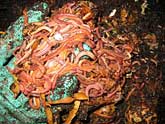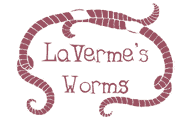ellensandbeck.com
Green Barbarians–Ellen Sandbeck

A Buddha A Day–Ellen Sandbeck


|
Elementary Worm Composting
A DEFINITION:
Vermicomposting is the scientific term for the homely art of harnessing the power of earthworms to increase the speed, ease, and efficiency of composting. In contrast to traditional composting methods, vermicomposting requires very little effort: after the compostable materials have been introduced into the bin, the worms do all the work. In fact, vermicomposting is so efficient and odorless that it makes a fine indoor hobby.
THE PRODUCT:
The end product, vermicompost, AKA worm castings, has passed through earthworms' digestive systems. Vermicompost is extremely lively: it contains more than 100x as many beneficial bacteria and fungii as can be found in the surrounding soil. It also contains plant growth factors and B vitamins, as well as high levels of soluble calcium, magnesium, phosphorus, and potassium. Vermicompost is Nature's most perfect fertilizer.
THE LIVESTOCK:
Red Wriggler composting worms, Eisenia fetida, are quite easy to keep in captivity. They make no noise and possess neither teeth nor hair to inflict bites or cause wheezing. They are entirely innocent of eyes, limbs, or ears, and are susceptible to fatal dehydration when in the open air, so they are generally loathe to run away. Even the most timid and allergic among us should have no trouble in keeping their composting worms under control.
THE SIMPLEST SETUP:
- A 20 gallon or larger plastic bin or wooden box, approximately 20 inches high. Drill a single half inch diameter hole in the bottom, near the front edge of the bin.
- A two foot length of synthetic rope, cord, or heavy yarn. Thread the rope through the hole in the bin, and tie a knot in the end that is big enough to keep the rope from pulling through the hole. This rope will serve as a wick to guide the flow of effluent (worm juice) out of the bin and into a milk jug that is set below the bin.
- A table, stand or blocks to set the bin up off the ground.
- Enough peat moss, finished compost, or coffee grounds to form a minimum 4 inch deep starting bed for the composting system.
Peat moss is somewhat hydrophobic: dampen it in water and squeeze out the excess moisture before putting it in the bin. If the coffee grounds or compost are dry, water them down.
- Pour a cupful of fine sand over the peat moss at the bottom of the bin. Worms, having no teeth, are dependent upon the grinding action provided by sand in their gizzards.
- Put at least a pound (more is better) of Red Wriggler worms on top of the damp peat moss or compost in the bin. They will dive to get away from the light.
- Put at least a 2 inch deep layer of dry leaves on top of the worm filled peat moss or compost. These dry leaves will hereinafter be referred to as -bedding-.
- Cut a piece of black plastic sheeting or out of a heavy duty leaf bag to fit the top of the bin. Lay the sheeting on top of the bedding layer to keep the worm compost moist so the worms will stay happy, healthy, and home.
SUITABLE FOODS:
Do feed: fruit and vegetable detritus, whole wheat products, dry leaves, plant trimmings
Don't feed: white flour products; salty foods (unless they are rinsed off); foods that contain preservatives; hay; straw; grass clippings; NEVER PUT NEWSPAPER IN A WORM BIN!!!!
FEEDING METHOD:
- A worm bin should be fed in rotation, one section per week, so that it takes a minimum of a month to return to the first section that was fed.
- Brush the bedding leaves aside, and use your hands to scoop a hole out of the compost --metal implements kill worms- and put the displaced compost in a bucket.
- Fill the hole with kitchen scraps. Pour the set-aside compost from the bucket onto the kitchen scraps. Smooth the compost over the scraps and make sure that the scraps are completely buried under at least 2 inches of clean compost.
- Add dry leaves until the bedding layer is at least 2 inches deep.
- Cover with the black plastic sheeting.
USING THE END PRODUCTS:
- Worm compost is extremely concentrated. Use it very sparingly. It is a fertilizer, not a soil amendment.
- Water worm juice down: one part worm juice to twenty parts water. Use it to fertilize plants.
Courtesy of Laverme's Worms
Reducing Waste Since 1988
Composting worms, composting bins for homes, schools, and institutions
(218) 721-4422
|




